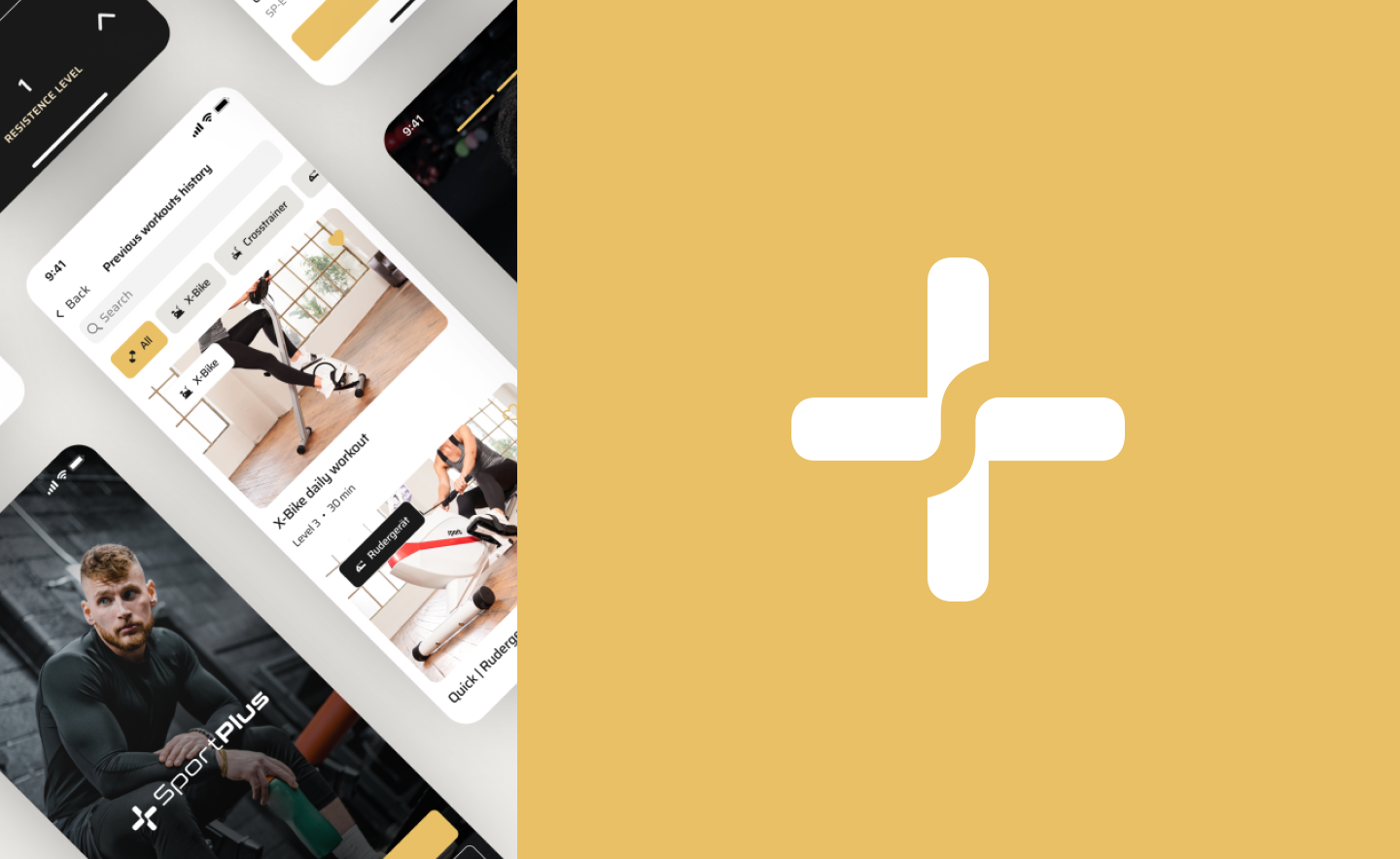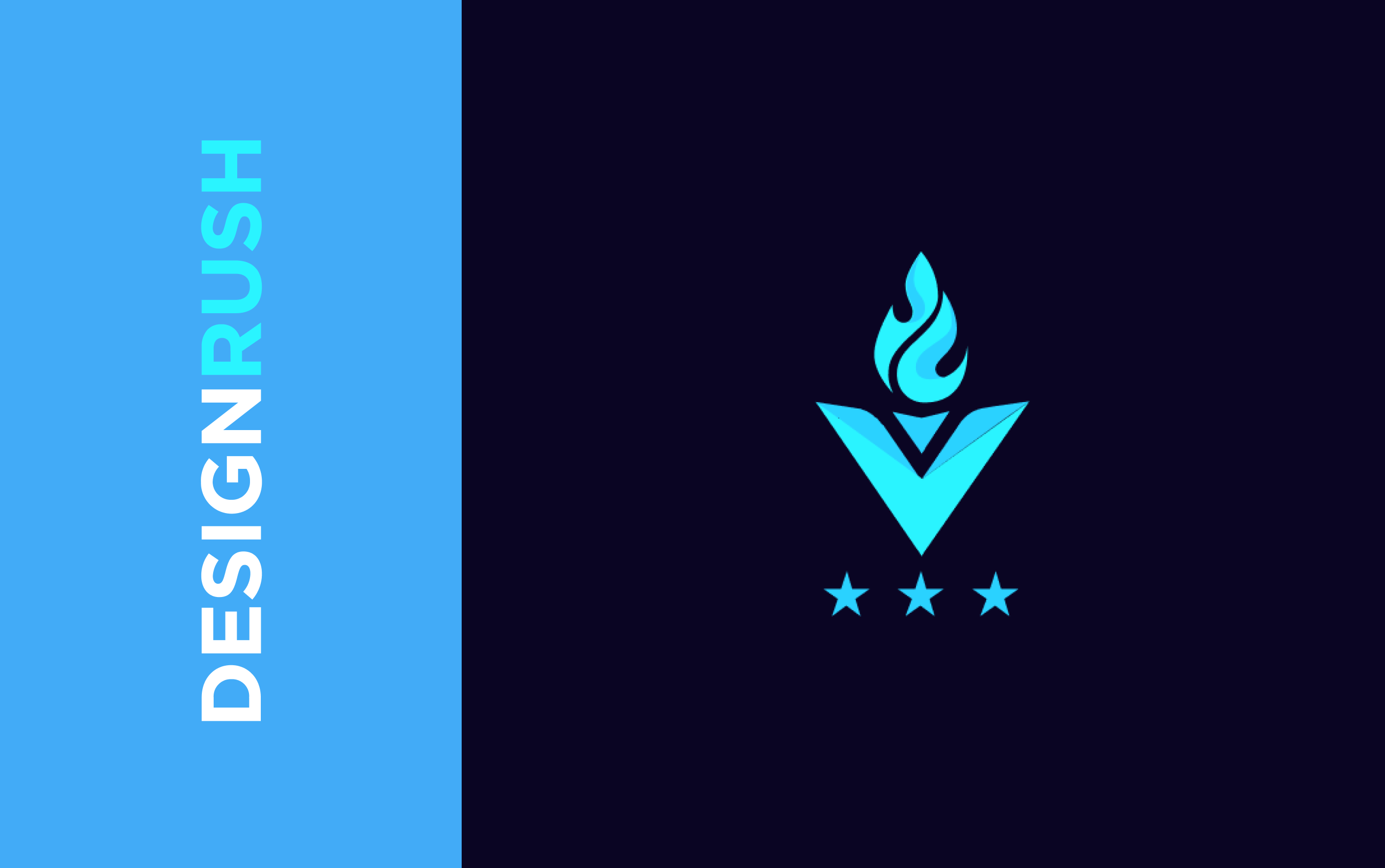Sport is vital in our lives, contributing to our well-being and mental clarity. It’s not uncommon for individuals to embark on a fitness journey with great enthusiasm. However, many give up due to needing more discipline or witnessing the desired outcomes. Fortunately, the fitness industry has embraced digitalization, so technology now offers solutions to these challenges.
Nowadays, plenty of fitness apps are available to assist those eager to improve their fitness levels. According to a recent report by Statista, the revenue generated in the Fitness segment has reached an impressive $4,024.9 million in 2021, and it continues to multiply. In fact, experts predict that the revenue will experience an annual growth rate of 5.0% from 2019 to 2023, resulting in a market volume of $20,499 million by 2023.
Unsurprisingly, numerous startups and companies are enthusiastically venturing into developing fitness apps. With such a promising market, there’s never been a better time to explore the world of fitness apps and discover how they can help you achieve your fitness goals.
So, if you’re looking to create a fitness app UI design that hits the mark and gives people what they want, you’ve come to the right place. In this article, we will walk you through the different types of fitness apps, how to create a killer fitness app UI design, and even how to make money from it. Sound good? Let’s dive in!
What are Fitness Apps?
Fitness apps are excellent tools for your smartphone or tablet. They allow us to conveniently monitor our health and fitness progress no matter where we are. According to Statista, the fitness app market is projected to generate a whopping 3,567.7 million U.S. dollars in global online revenue by 2024. Additionally, during the same period, fitness wearables are expected to create an impressive gain of 17,863.9 million. These numbers demonstrate these tools’ growing popularity and importance in pursuing a healthier lifestyle.
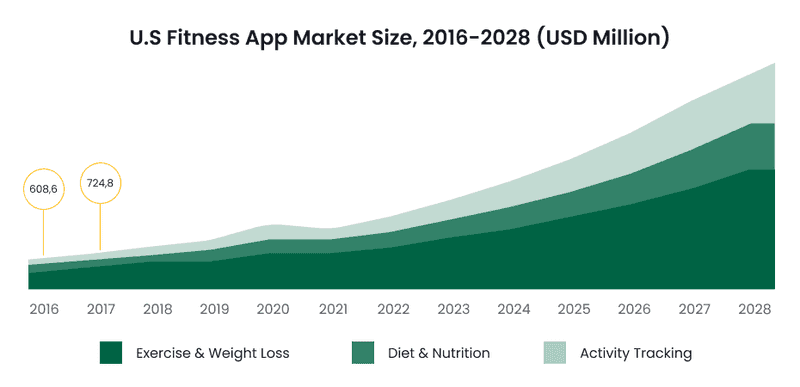
The benefits of using fitness apps are genuinely remarkable. They provide users personalized workout routines to monitor their progress and stay motivated. If the user needs help with exercise techniques, that is not a problem! Fitness apps even let users track essential factors like calories burned, heart rate, and sleep patterns, giving them a complete view of their health and well-being.
Yet, fitness-tracking app downloads have boomed in recent years. App diversity and availability have also increased since the popularity of health apps has risen. Since 2015, the number of apps available for download from the Apple store has almost doubled.
Types of Fitness Apps
It may seem that fitness apps only show information about workouts. But in fact, these apps may offer much more. There are different apps for almost every activity that is related to health. Let’s discover each type.
Activity trackers
The essence lies in its name - these apps help users to track their physical activity. One of the key features is the step tracker, which diligently analyzes the user’s movement throughout the day. Additionally, the user can activate the running or cycling mode, or even the swimming mode, to ensure that the indicators are as accurate as possible and the app can remember your route. Moreover, the activity tracker can easily connect to the user’s wearables, phone’s gyrometer, or even exercise machines. Rest assured, these apps are here to support the user every step of the way on their fitness journey.
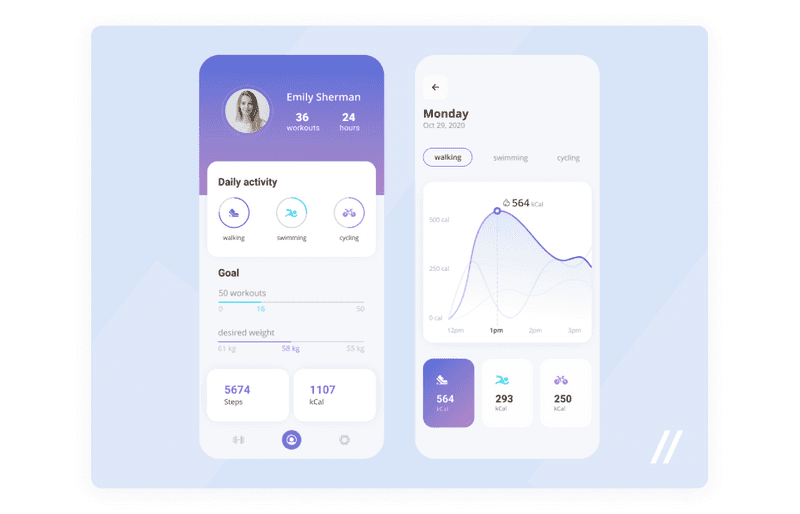
Dribbble shot by Purrweb UI/UX Agency
Then, the data is sorted into progress charts so the user can see his progress. Yet, it may even show competitive data so the user sees how he is doing compared to other users. It boosts motivation and helps to see how quickly the user progresses towards their goal.
Workout App
In the world of health and fitness apps, workout applications dominate, accounting for a whopping 73% of all health and fitness app sessions. When delving into the workout design app, it’s crucial to consider the user’s experience. Users expect the ability to seamlessly track their activity during workouts and access information about calorie burn, health impact, and the muscle groups engaged in their training. To ensure user-friendliness, it’s essential to thoughtfully arrange information on the screens, ensuring readability and contrast for all users.

Dribbble shot by SylGraph
These apps go beyond offering just information; they deliver the workouts themselves. Users can access pre-recorded workout sessions conveniently played on their phones or tablets, adding a dynamic dimension to their fitness routine.
Additionally, workout apps often feature extensive libraries of diverse workout types and can track users’ progress, recording how much of the activity was completed. And what’s great is that monetization opportunities are significant there, with options like providing exclusive workout programs and more.
Consider exploring our blog’s comprehensive article for a deeper dive into crafting a compelling workout program design. This resource offers detailed insights into workout program design, enhancing user engagement, and delivering an exceptional user experience. It’s your guide to creating fitness apps that inform and captivate your audience.
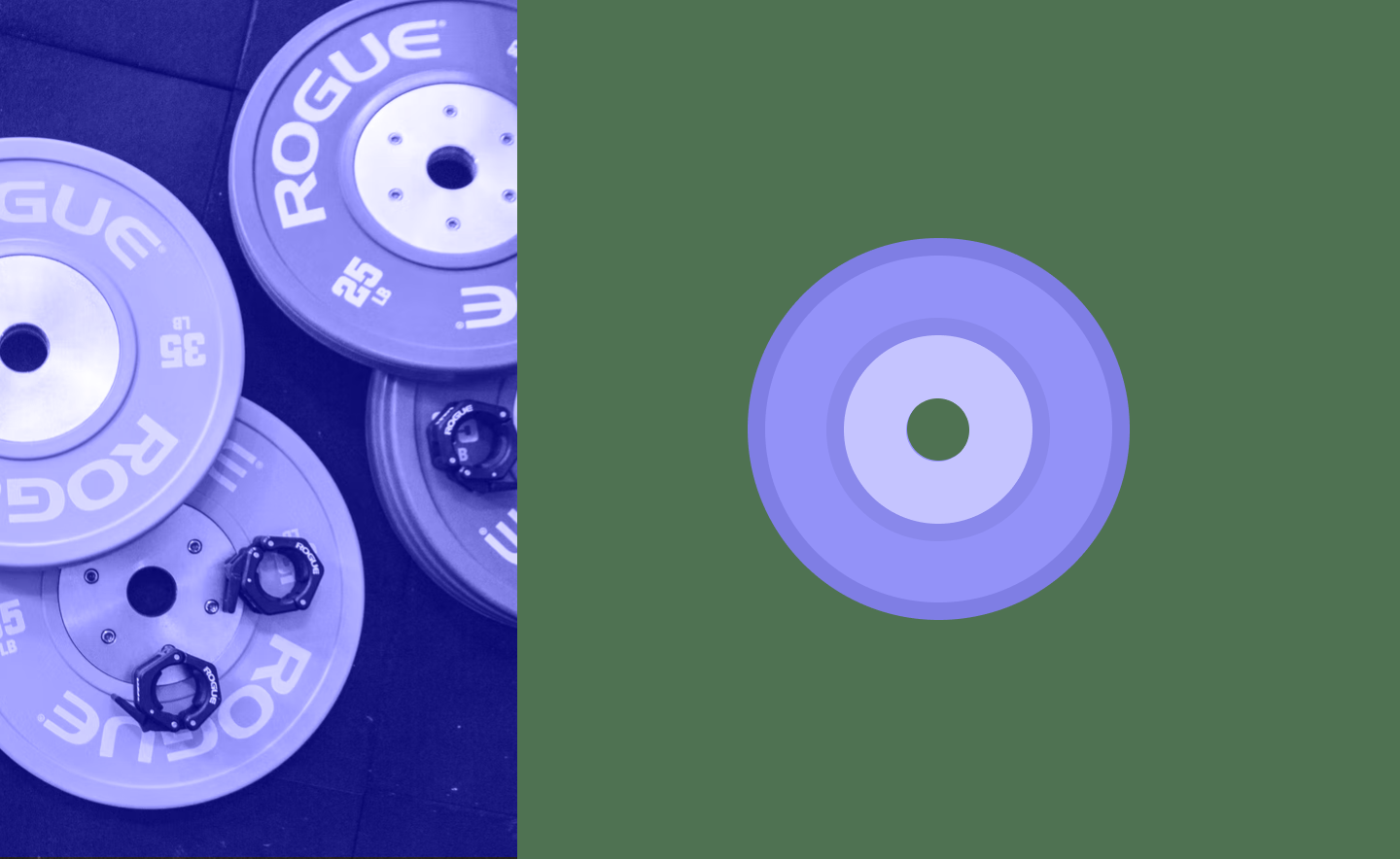
Build a Workout App to Overcome Your Competition And Stand Out In A Market
Personal Trainer App
This type of app is a bit similar to the previous type, but workouts here are more personalized by the level of complexity and user’s goal. These apps can also show how exactly the exercises should be done. Consider videos, 3D models, animations, or illustrations when thinking about workout program design.
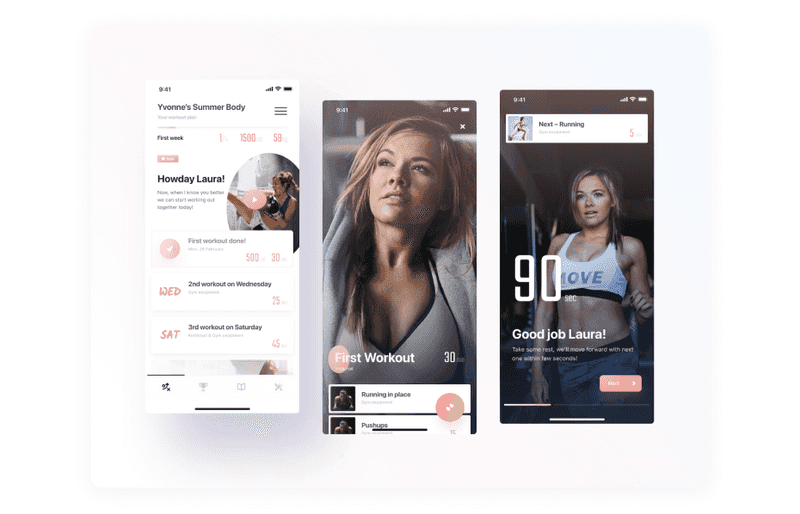
Dribbble shot by tonik
Yet, some personal trainers and studios have their own custom apps. There can be options that allow users to choose a trainer or to look for a training schedule. A newsfeed with helpful information may work well here. Besides, there can be live streams and online workout sessions from coaches, which may be prevalent in connection with last year’s events.
Yoga App
Another type is the yoga app. As per the recent Google data, the number of searches around yoga and meditation apps, like ‘yoga for beginners app’ and ‘mindfulness apps, have increased by 65% YoY. It shows us that apps like these are in demand. The global yoga market is forecast to reach $66.2 billion by 2027 and is expected to have a compound annual growth rate of 9.6% from 2021 to 2027. (AP News, 2020)
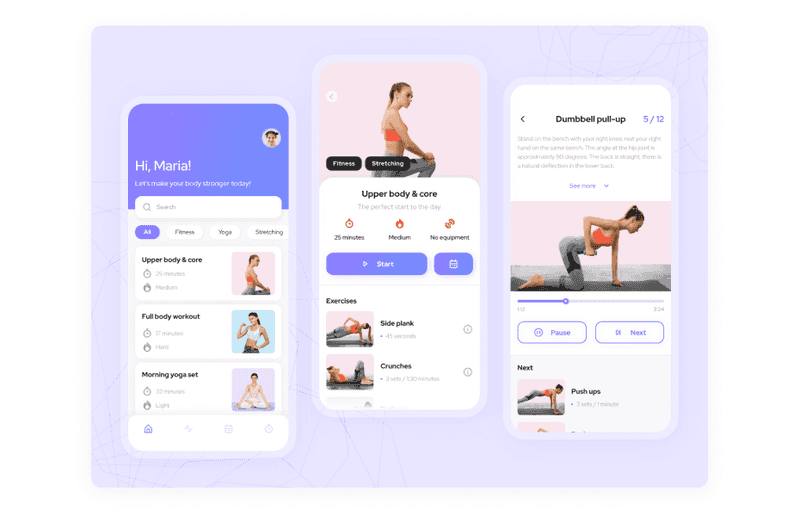
Dribbble shot by Axicube
A yoga app is a digital platform designed to facilitate and enhance yoga practice for individuals of all skill levels. These applications offer various features and resources to help users engage in yoga, from beginners to seasoned practitioners. They typically provide guided yoga sessions, a variety of yoga styles, meditation practices, and instructional videos led by certified yoga instructors. Yoga apps also often include features for tracking progress, setting goals, and maintaining a consistent yoga routine.
Consider building a smooth and elegant fitness app design if you create a yoga app. It should have a clear structure and attractive images, bringing comfort and calm to the user. Yet, if you want to know more about how to build a great yoga app that users would like, read our article on this topic.

How to Design an Incredible Yoga App: Insights
Diet and Nutrition App
Nutrition and diet apps are great for users who want to improve their eating habits. According to the survey, 26 percent of people aged 18 to 29 regularly use apps to track their diet and nutrition.
It also may help them to lose or gain weight. Diet apps can track protein, carbohydrates, fiber, and fats consumed. Also, such applications can track the amount of water and coffee drunk, affecting progress. Sometimes, these apps show you how many calories you’ve burned daily. This type of fitness app may be combined with an activity tracker, which may increase efficiency.
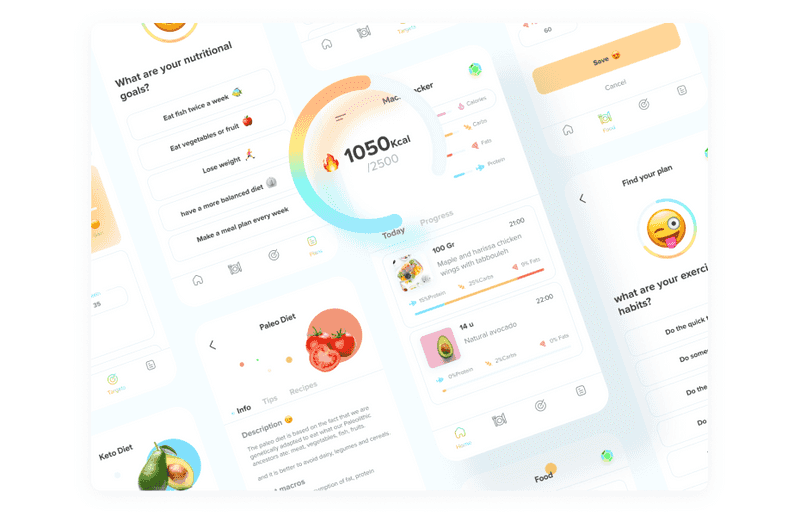
Dribbble shot by Orizon: UI/UX Design Agency
Key Features to Create a Fitness App
Previously, we discussed different types of fitness apps. But one thing goes like a red thread through each type. The success of the app depends on attractive features.
-
Sign Up
Registration is a crucial step for many apps. While it may not be mandatory for your app, users must provide some information during registration to offer personalized training and a tailored diet plan.
Consider allowing users to sign up using their Apple ID, Facebook, or Gmail accounts to make things quicker and more straightforward. Gathering more data can enhance the user experience and provide targeted marketing based on user preferences. Having all the necessary information will also enable you to understand your users better.
-
User Profile
Let users create their profiles in your app. When providing personal workout programs, they can add detailed information about their weight, age, and other essential parameters. This information will help you count burned calories accurately and personalize your app, vital in our digitized reality.
-
Activity Tracking
All data from exercises should be available. It can also be delivered from wearables. Yet, the app can track step activity, giving a user a complete understanding of his degree of movability. Devices like smartwatches, fitness trackers, and other wearables will provide you with more data about user activity.
In the future, you can create an app for exact wearable devices so users can leave their smartphones at home and still get the same features on their wearables.
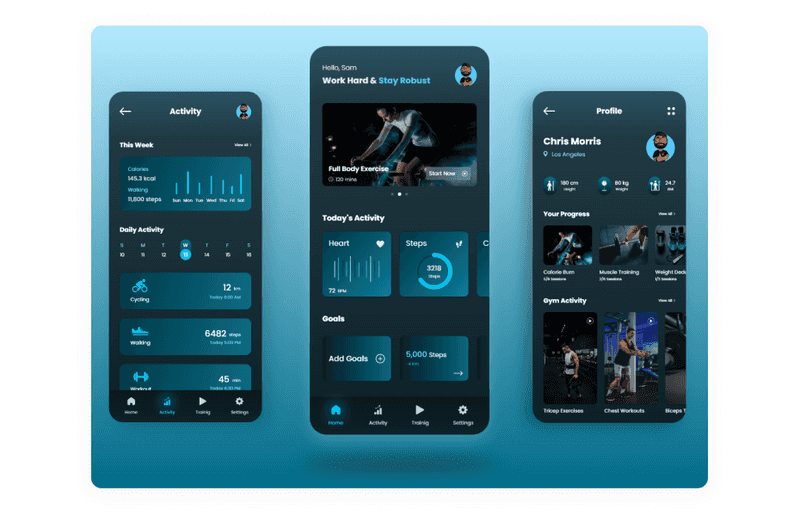
Dribbble shot by sumanth karanam
-
Calorie counter
The calorie counter is another vital feature in your nutrition or workout app. It will allow users to track the number of calories consumed and the number of calories burned while exercising or throughout the day.
-
Statistics
These can be local and global. Local statistics may show short-term data about progress from one workout to another. It can show cadence, distance, heart rate, etc. With this kind of stats, the user can monitor his activity during each workout. The second type of stats is the global one.
Global statistics can show progress on chosen periods, for example, for a month or a week. This statistic helps track the whole progress of intensity on weight loss.

Dribbble shot by Piqo Studio
-
Geolocation
A feature like this will help users calculate the distance and have correct data about their route and the miles passed. It would be good if there would be a visible map for clarity
-
Social Sharing
This feature allows users to share their achievements, workouts, and progress on social media, which can inspire others and create a community around the app.
-
Settings
It is vital to allow users to customize the colors or sounds of the app. Provide night mode for those who don’t like bright and light colors.
-
Push Notifications
This feature is mandatory for almost every app. With the help of this, you can share new features with your users. It is an additional tool to involve users in the application.
-
Payment Gateway
Consider providing a secure payment method so users can pay for workouts without problems.
Extra Features For Outstanding App
The recent features we discussed are essential, but what can make your app notable? These additional options highlight your product and can help users with their needs.
-
Gamification
It may give an additional boost of motivation to users through entertainment. You can provide different rewards, badges, and levels to complete so users maybe even more involved.
-
Live-streaming
Professional coaches can go live and organize groups for training. People can connect and repeat after the trainer. With this, people can gather in a group united by a common interest. Yet, they can consult a coach and discuss some questions.
-
Trainer on demand
You can let users arrange personal training with professional coaches. The app should have a schedule if you want to provide this feature. Thus, coaches will be able to manage all their clients.
-
Community and challenges
Add a bit of competition. You can create some leagues of users to get points for each goal completed. Those users with many points can move to the next level of the league. You can reward users with badges or even play a free membership.
-
Educational content
Text instructions, valuable articles, and video tutorials may be exciting and helpful to users. Providing this feature can increase interaction with your app.
-
Barcode scanner
It can be a beneficial feature in diet and nutrition apps. Scanning the barcode instead of searching for the product in the database is easier. People don’t like to wait for too long. It can also help to get more information about the manufacturer and the whole composition of the product.
-
Goal setting
Some people feel motivated when they set goals. Let them reach everything they want to get.
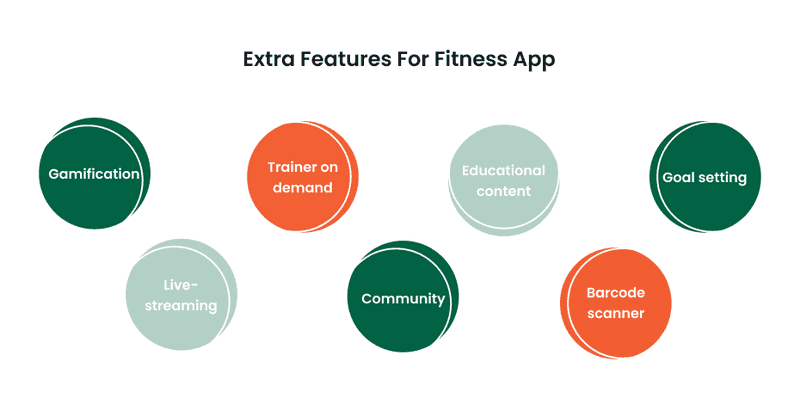
When it comes to fitness app design, it’s important to consider integrating some extra features that can really make your application shine and meet the specific needs of your users. You can create a fitness platform that has it all by incorporating gamification, live-streaming, trainer-on-demand, community and challenges, educational content, barcode scanning, and goal-setting functionalities.
Not only will these additional features motivate and engage users, but they will also provide them with a comprehensive toolkit for achieving their health and fitness goals. With these features, your app will be a fitness tool and a holistic wellness experience that users will truly appreciate on their fitness journey.
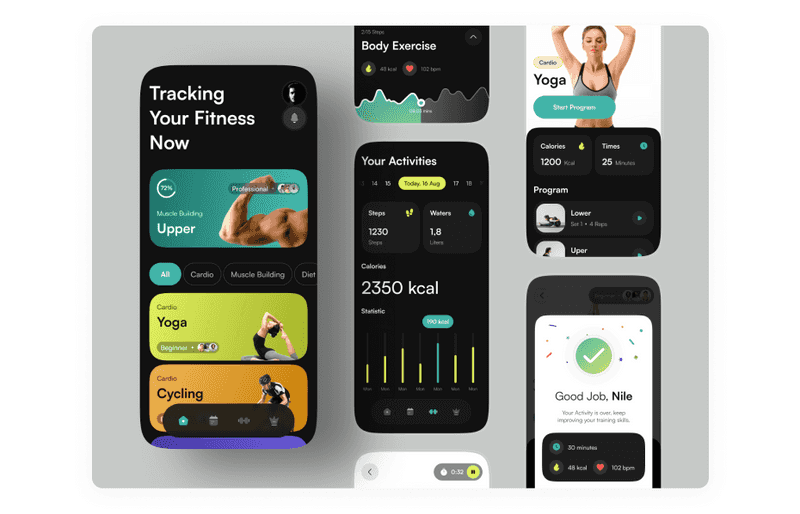
Dribbble shot by Paperpillar
Now, we focus on a critical aspect of app development—accessibility features. Ensuring that fitness app design is accessible to all individuals, regardless of their physical or cognitive abilities, is not just a moral imperative; it’s a legal requirement in many regions.
Accessibility Features in a Fitness App
Ensuring that fitness app design is accessible to a wide range of users, including those with disabilities, is not just a matter of inclusivity—it’s a legal requirement in many regions. Moreover, it will simplify the app usage during the workout session. These features could be easily adapted to use the fitness app on the go. Here’s a list of essential accessibility features, along with their descriptions and why they are crucial:
-
Voice commands and voice feedback
Allow users to interact with the app and receive feedback through voice commands, making it accessible to those with mobility or visual impairments. Such a feature provides an alternative means of navigation and control for users who may have difficulty with touch interfaces.
-
Screen reader compatibility
Ensure compatibility with screen reader software, which reads on-screen text aloud and instructions for visually impaired users. It will let such users access and navigate the app effectively.
-
Text-to-speech for content
Convert text-based content, such as workout instructions or articles, into speech for users with difficulty reading.
-
High-contrast and extensive font options
Offer settings for high-contrast themes and larger font sizes. It will enhance readability and usability for users who require clearer and larger text.
-
Alternative navigation methods
Provide alternative navigation pathways like gesture shortcuts, keyboard commands, or simplified menu structures. It would help users with dexterity or delicate motor skill issues to navigate the app efficiently.
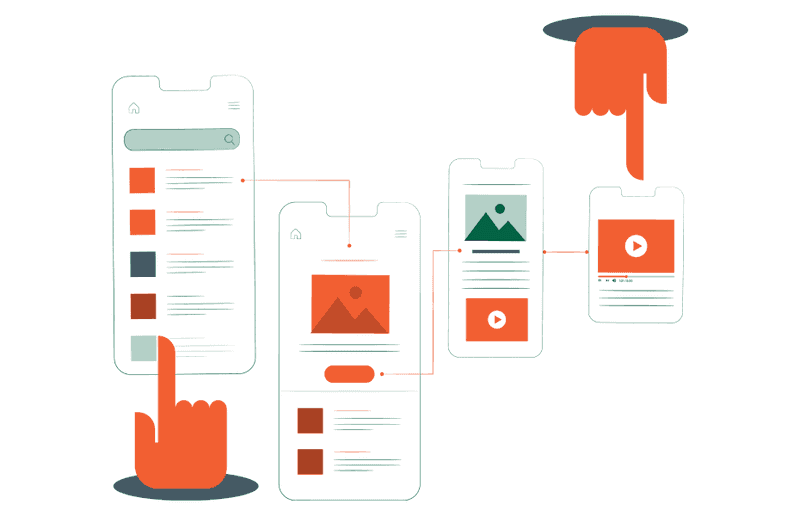
-
Closed captioning for videos
Add closed captions to instructional workout videos, allowing users with hearing impairments to follow along.
-
Customizable timing and alerts
Enable users to adjust the timing and frequency of notifications and alerts, essential for users with attention disorders or sensory sensitivities. Such a feature would promote a comfortable and user-friendly experience for individuals who require tailored notifications.
-
Multi-language support
Include options for changing the app’s language to accommodate users who are not fluent in the app’s default language.
-
Compatibility with accessibility tools
Ensure the app works seamlessly with external accessibility tools and assistive devices, such as screen readers and Braille displays.
-
Clear and consistent fitness app UI design
Maintain a straightforward and consistent user interface design that is easy to understand and navigate.
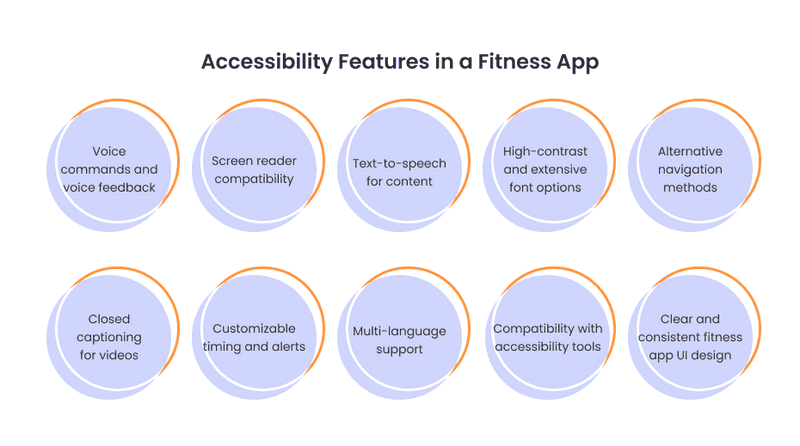
However, if you are still looking for a comprehensive understanding of accessibility features in fitness apps, look no further. Our blog features an in-depth article dedicated to accessibility, its significance, and its implications. Make fitness more inclusive by exploring the valuable insights in our dedicated accessibility blog post.

Accessibility Design Matters: Why is it So Important?
And now, let’s look at the most noteworthy trends in 2023 in the fitness app development industry. As we progress, it’s essential to consider the ever-changing landscape of fitness technology trends in 2023 and beyond. It will inspire you and encourage you to explore new features that will keep your app at the forefront of the industry. So, without further ado, let’s dive into some of the most significant fitness technology trends for the future.
Biggest Fitness Technology Trends in 2023 and Beyond
In the changing world of fitness and well-being, staying in the game by embracing innovation is crucial. Fitness applications have undergone advancements, offering a range of features and functionalities that cater to users’ diverse needs and preferences. To remain competitive and meet the evolving requirements of healthy individuals, it is essential to keep track of emerging trends in fitness app development.
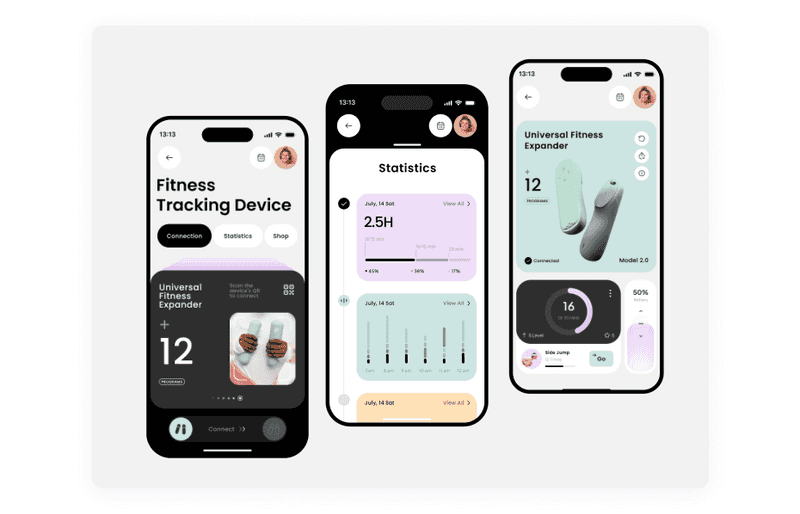
Dribbble shot by Awsmd
This section will explore the trends and innovations that are shaping the landscape of fitness apps. These trends, from state-of-the-art technologies to user-focused features, redefine how we approach fitness and influence fitness apps’ design, functionality, and user experience. So, let’s delve into these trends that are driving the future of the fitness app industry.
Artificial Intelligence
Artificial intelligence (AI) is increasingly vital in revolutionizing how trainers and fitness enthusiasts approach their workouts in the rapidly evolving fitness landscape. Here are a few ways this technology can be used in fitness app development:
-
AI-powered pose estimation
Users can completely transform their exercise routines by integrating AI-powered pose estimation into fitness apps. This incredible feature provides real-time feedback on form and technique, ensuring effective workouts.
It also functions as a coach, monitoring users’ advancement and providing advice. With this technology, your app’s users will feel more involved and motivated. Additionally, this breakthrough is vital in preventing injuries and aiding users in reaching their fitness objectives by ensuring posture.
-
AI Assistants
AI-driven personal assistants streamline the administrative aspects of personal training businesses. These virtual assistants can transcribe notes, send messages, make calls, and more, enabling trainers to focus on their clients. This feature is well implemented in ALFA AI.
-
Personalization
Artificial intelligence can also be used to create personal training plans. AI can use analytics gathered from millions of other workouts to provide clients with optimal sets, reps, and weights based on their goals. An excellent examples are the FitnessAI app, Gymfitty, and Fitbod.

FitnessAI app screens
-
Generative AI
AI’s generative capabilities extend to content creation, including text, images, and videos. Tools like ChatGPT and DALL-E transform fitness professionals’ development of blog posts, social media content, and communication materials. These AI-powered solutions offer unprecedented creative support.
The fusion of AI and fitness is reshaping the industry, providing trainers and enthusiasts with powerful tools to enhance workouts, monitor progress, and optimize performance.
VR and AR
Integrating augmented reality (AR) and virtual reality (VR) technologies has become a game-changer in the realm of fitness app design and workout program development. These cutting-edge advancements are not just eye-catching but offer a multitude of benefits for both fitness enthusiasts and app creators. In this section, we explore how AR and VR technologies can reshape fitness apps, providing enhanced experiences, motivating users, giving a competitive edge, and expanding the app’s reach to new audiences.
-
Enhanced brand visibility
Incorporating AR and VR technologies into fitness app design captivates the attention of our tech-savvy, younger, and affluent audience. Beyond grabbing their focus, it cements our brand’s reputation as a modern entity delivering exceptional user experiences.
-
Motivation
Research indicates that nearly 44% of individuals refrain from exercise due to its perceived lack of excitement. The monotony of repetitive tasks can lead to boredom. Fitness apps may employ VR technology to inject enthusiasm into workouts and AR to make exercise engaging, effective, and safe. Immersion in virtual environments and the gamification of workouts divert the mind from exercise-induced discomfort, making fitness a more enjoyable and motivating experience.
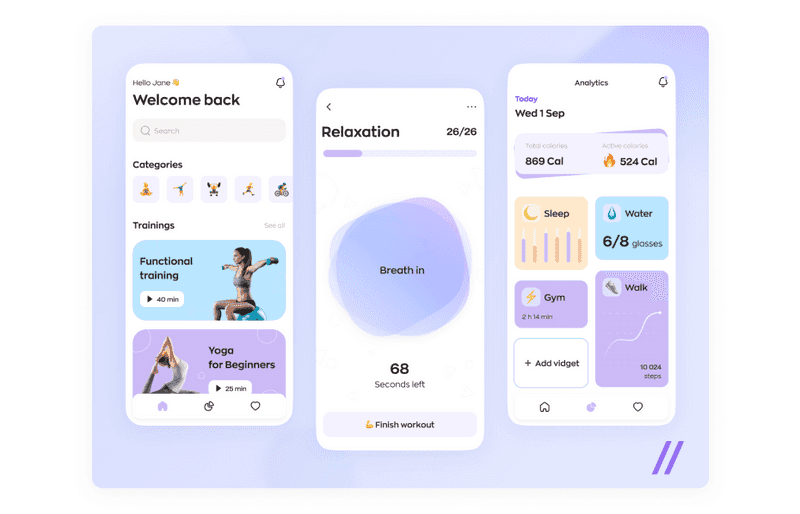
Dribbble shot by Purrweb UI/UX Agency
-
Competitive advantage
By offering stimulating immersive experiences, gamification, and enhanced efficiency through AR/VR features, fitness apps gain a significant advantage over competitors. This transformation often leads to the app being referred to as a “VR fitness app,” setting new standards for the industry.
-
Reaching new audiences
While VR is often associated with the gaming demographic, including teens and individuals in their 20s, fitness-oriented VR experiences have the potential to attract users who may not have previously considered fitness activities. VR home workouts appeal to those who feel uncomfortable exercising in public, while advanced sensors, navigation, and statistics cater to the needs of professional athletes.
Incorporating AR and VR technologies into fitness app design is a technological leap and a revolution in how we approach exercise and well-being. These advancements enrich user experiences, inspire individuals to lead healthier lives, provide a competitive edge for fitness apps, and open new avenues for engaging diverse audiences in the world of fitness and wellness.
Integration With Telemedicine
In today’s ever-evolving world, we are witnessing remarkable technological advancements that are revolutionizing fitness and health. And one of the most exciting trends in this field is the integration of telemedicine. This trend brings together the power of physical activity and the convenience of digital healthcare resources, offering us a whole new way to monitor our health and make progress in our workouts.
With this incredible integration, users can receive real-time consultations, get prescriptions, and receive guidance without ever having to leave the application. It’s like having a virtual doctor’s office right in your pocket! So whether the user has a question about their workout routine, needs nutrition advice, or requires expert guidance for physical therapy, these apps have covered them.

Dribbble shot by Emote
Why is this trend exciting? It offers a personalized approach, enabling users to receive tailored recommendations considering their unique needs and health conditions. It facilitates continual health monitoring, allowing users to track their physical well-being and access immediate assistance and consultations. It is particularly crucial for individuals managing chronic conditions or undergoing rehabilitation. Moreover, it boosts motivation. Knowing they have the support of healthcare professionals, users feel more motivated to achieve their fitness goals and care for their well-being.
Why is it a trend? Recent events like the pandemic have intensified the demand for telemedicine services and underscored the importance of remote interactions with medical professionals. Therefore, integrating telemedicine has become a natural progression for fitness apps aiming to provide comprehensive healthcare for their users. This trend epitomizes the future of health and fitness, where technology unites the worlds of workouts and medicine for the benefit of everyone.

Dribbble shot by tubik
As we witness the transformative potential of integrating telemedicine into fitness apps, let’s shift our focus to another crucial aspect of the fitness app landscape: monetization strategies. Discover how these apps are not only enhancing health but also reshaping business models in the fitness industry.
How to monetize a fitness app?
It is necessary to draw your attention to monetization opportunities. If you plan your monetization options well, it can become a good feature for your app. Monetization should never impact a user’s experience negatively. You can choose something suitable from the following options:
-
Paid apps
The cost is charged upfront when a user downloads the app. It can be a good practice for companies to charge a symbolic fee from users. But people have different opinions on this. Some still prefer free apps, and some perceive it as a good sign of service that can be trusted.
-
Freemium
The user downloads the app for free but pays a one-time fee or subscription to unlock the premium features set.
-
In-app purchase
With this type of monetization, the app is downloaded for free, but users can buy some extra features and content with in-app purchases.
-
Sponsored content
You can find some partners who would buy space in your app to provide workshops and consultations for your users. With this type of monetization, both of you have a profit.
-
Ads
These can be banners, native ads, or video ads. Good advertising will increase interaction with your app if you think it over correctly. When planning fitness app design, consider where you can put the place for advertisement if you want to choose this type of monetization.
-
Workout market place
The app is free, but coaches can upload paid videos, and people can buy them or use those that are freely available for everyone.
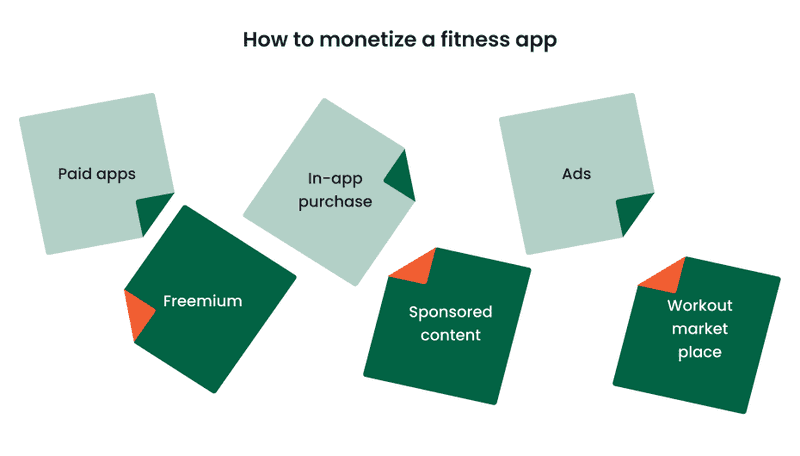
How to Start a Fitness App
Once you have familiarized yourself with the concept of a fitness application and its main features, it’s time to dive into creating your very own app. You’ll need to develop a solid idea and determine the best business model to bring it to life. Don’t worry. We are here to guide you through the process and help you consider all the critical factors. Let’s get started, shall we?
-
Type of fitness app and critical activities
Decide on your idea. Think about what type of fitness app you want to create and what features will be there.
-
Value proposition
What do you want to provide your customers with? How will your product differ from the rest? Think it over.
-
Monetization
Think about what additional profit you can get from the app. There is more than one way to monetize an app.
-
App promotion
Even if you created an excellent app, more is needed to make people notice it. Prepare an advertising campaign and think of marketing channels to promote your app.
-
Users engagement
To be honest, many of us promise to start a workout in the morning, from Monday, etc. If you want to be helpful, think about how to engage the user. You need to be gentle but persistent. It could be push notifications, gamification, etc.
You can build a good strategy basis if you think about all these points well. The role of the strategy is, first, to help focus attention on specific areas and opportunities, second, to discard all other possibilities as incompatible with the strategy. This can be the first step in launching a successful app.
Market Research
Before you begin your development journey, take some time to analyze your competitors. By doing so, you will gain valuable insights and be able to define your target audience more effectively. It can be achieved by determining the type of fitness app you wish to create. To simplify this process, I recommend utilizing the primary app stores such as Google Play or App Store. Once there, you can quickly sort the apps by the chosen category and thoroughly study each. Take note of why these apps have gained popularity and what specific features, design elements, and subscription prices they offer.
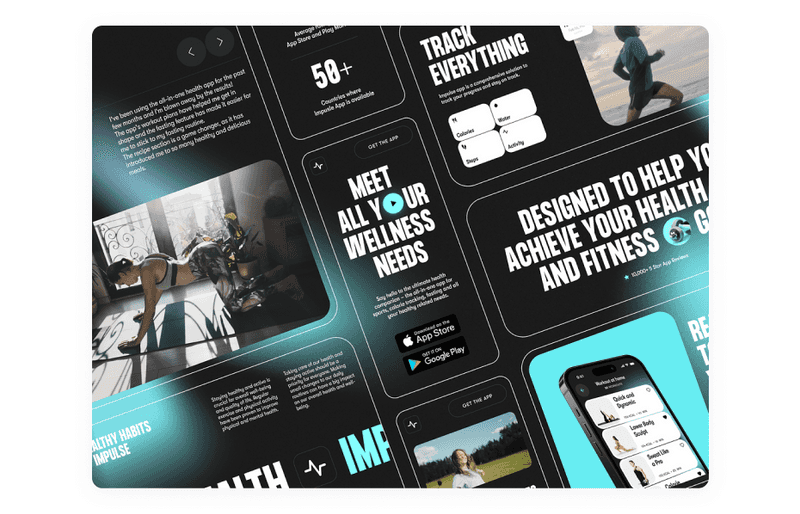
Dribbble shot by tubik
By conducting this research, you will be equipped to consider your fitness app’s future design and features carefully. It will undoubtedly contribute to its success and ensure that you develop a product that truly meets the needs and desires of your target audience.
Who do you design for?
When you do market research, you learn what works well. Understanding user personas will help you and your team fully understand your future clients. It’s crucial to set customer’s needs, wants, and expectations as a top priority for your fitness app design. To deliver value to the customer, you must closely collaborate and satisfy their requirements. Yet, fitness app UI design may depend on your audience’s age, gender, and cultural background. Driven by this, you will be able to create a user-centric design.
Dive deeper into the topic of user research and read our previous article. We talk about all user research methods used for different goals.

Essential UX Research Methods For Your Business
Visualize the user journey
Once user personas are defined, consider the user’s tasks in your app. The user flow includes names, actions, users, and descriptions of each step. Reduce redundancy to make it easier and faster for users to achieve their goals.
After defining the user flow, you will know what modules, screens, or sections your interface requires. It will be the skeleton of your app. With this, we can come closer to the fitness app design process.
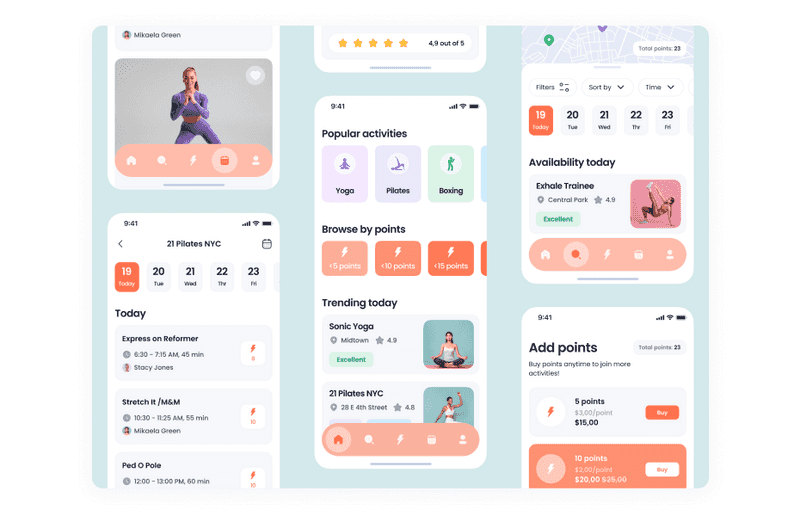
Dribbble shot by Fireart Studio
Wireframes and Prototypes
After User Flow is done, it is time to step into the wireframing process. At this stage, you will see the whole structure of your app. Use low-fidelity prototypes to define your app’s screens, layouts, navigation, and functionality.
Our blog already has a detailed article about wireframes. If you want to read about this fitness app design stage in detail, follow the link below. We promise you won’t regret it! Our article succinctly reveals aspects of the topic of wireframes, starting with what it is and ending with how it is done and why.

What is a Wireframe Web Design and Why Do You Need it
The functionality of fitness apps gives people lots of opportunities. Designers should understand the impact these apps have on a user’s life. So, that will help them improve the problem-solving potential of fitness apps. After wireframing and prototyping, we can jump into fitness app UI design next.
A UI Design Principles Fitness App Should Follow
A fitness app is like a mini instructor telling you how to keep fit and giving you feedback and motivation on your achievements. Consider an effective fitness app UI design to make this more comfortable and usable. To make it, take a look at these points:
-
Colors
Color influences how we see things. Picking the right colors for your fitness app is essential. The wrong colors can make your app hard to use. Remember, people might use your app while exercising, so it must be easy to see even when moving.
Moreover, it is crucial to consider the preferences of your target audience. People may like different color shades depending on age, culture, and gender. Try to look for fitness app design inspiration. You will discover that airy and bright colors are favorites regarding fitness app UI design.
By the way, we have an article on colors and their meaning for design and increasing user engagement. If you are interested, follow the link below. It will be enthralling there.

Color Psychology: How to Choose Colors That Attract Customers?
-
Attention to the main thing
It is essential not to overload screens with needless information. Screens shouldn’t look chaotic. Highlight the main elements. People who download a fitness app have a specific goal of using it. The fitness app UI design should be understandable and smooth so nothing will distract the user’s attention.
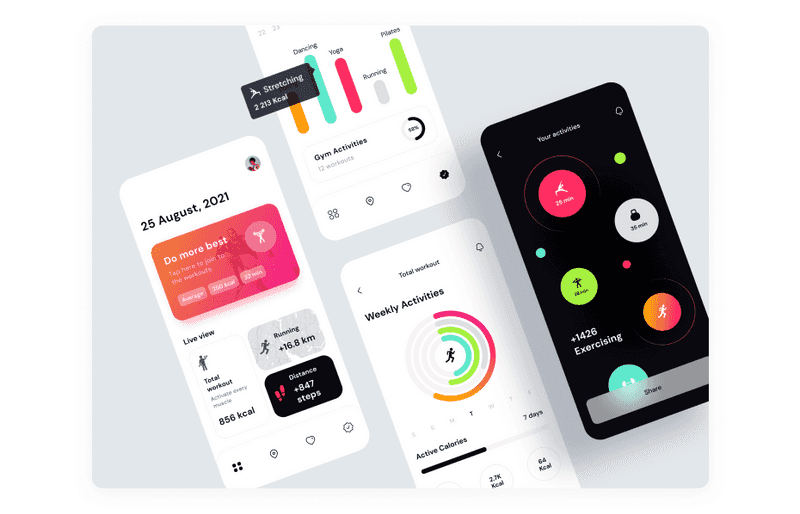
Dribbble shot by Arounda
-
Data visualization
Diagrams of various forms work great when it comes to visualizing user’s activity information. It can be understood even without lots of text. This type of visualization doesn’t overload the screen, so the fitness app UI design looks clean even if the user has an active life. After all, people also use fitness apps to see their activity statistics.
-
Animations
You can provide loading or progress animation to add entertaining elements to your fitness app design. Also, if the animations are designed elegantly, users will want to show them to others, which may engage more users in your app. You can also animate statistics and diagrams in your app, increasing the interaction. Yet, it can help make workout program design better.
-
Illustrations
If you want to pay the user’s attention to something, illustrations are good for it. They work well on onboarding tutorials. Yet, it looks good in workout program design when you want to show users how the exact exercise performs. It will also add personalization to your fitness app UI design. That is important if you want to create a user-centered design.
-
Icons
Icons in fitness app design are valuable for communicating actions and information quickly while saving screen space. They offer universal understanding and enhance user experience.
When creating icons, focus on clarity, consistency, and relevance, and ensure they work well in terms of size, color, and touch targets. Icons should be user-tested for intuitiveness and scalability for different screen sizes. In fitness apps, icons are not just for aesthetics; they are functional tools that guide users through their fitness journey, making them a critical element in UI design.

Dribbble shot by Vektora
-
Branding and Logo design
Branding is essential because it gives your clients the first impression of you. It can provide some associations with them so they will know what to expect from your product. Think about what impression you want to make. Friendly? Reliable? One of the leading branding components is the logo. When you think about investing in your workout logo design, remember that it should be memorable and catchy to separate you from your competitors.
No matter how many fitness apps are there, you have a way to make it unique. Valuable features, great UX, and eye-catching fitness app UI design can help you make an outstanding app.
In this section, we’ve outlined the steps you need to go through to create a killer fitness app design. And at the link below, you can find an article on our blog about the stages of the design process. There, we described everything in great detail. And we move on.

How Do the Perfect Design Process Steps Look?
How Axicube Builds a Fitness App Design
Our client, Force USA, specializes in crafting top-notch home workout gear, particularly All-In-One machines. Our team created a fitness app design to complement these, providing personalized strength programs for users to help them achieve their fitness goals. Our workout program design creates a holistic ecosystem, guiding users from beginners to seasoned pros in their home gym.
Our challenge was to tailor unique solutions for various user profiles, incorporating features like autoplay functionality and video tutorials for a user-friendly experience. We visualized users’ progress with four key metrics, shaping them into a pyramid during a collaborative Proof of Concept (PoC) with the Tech Lead—this showcased users’ alignment with training goals and proximity to ideal results.
As a result, our app maximizes the Force USA machine’s potential. Users receive tailored training plans aligned with their goals and video tips for correct exercise execution. If you feel as excited about this case as we are, you can read more about it in our portfolio.
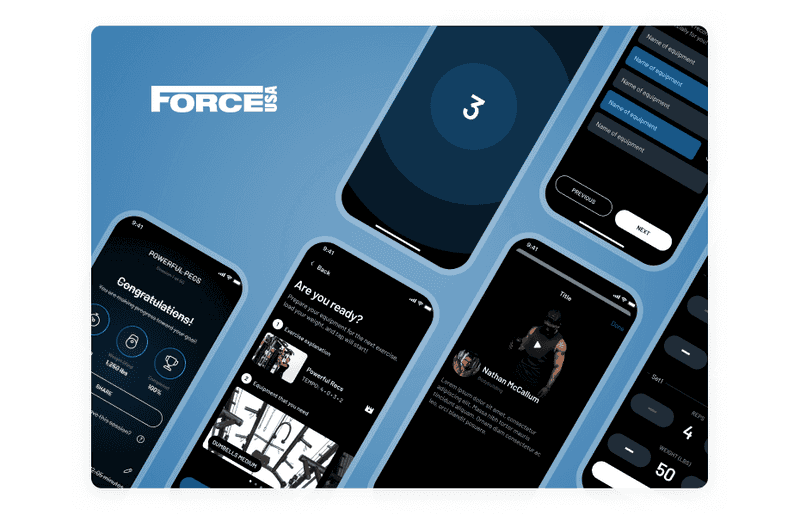
What Challenges Can Be Faced During Creating Fitness App Design
While creating a fitness app, you can face as many challenges as you do in building another app. But, there may be even more challenges because this app requires a geolocation feature and user-entered data. Here we described some common problems you can face when creating a fitness app:
-
Data security
A fitness app usually takes data from different wearables and sensors. Data can be stored on a user’s device or on a cloud server, which can be a target of hackers. An attack based on a user’s habits is possible, and hackers can access confidential information. So, it is crucial to consider taking measures to protect user data and privacy.
-
Legal adherence
Ensuring the app complies with relevant health and fitness regulations and industry standards to avoid legal complications.
-
Regular updates
Fitness apps have lots of opportunities. That’s why you should think about extra features that may appear in your app in the future. Regular updates are necessary to retain users on your app for a long time.
-
Trend awareness
Staying up to date with fitness app design trends and ensuring the app remains competitive in a rapidly evolving fitness tech market.

Dribbble shot by indianpix
-
Design that ignores people
The fitness app design should cover all the user’s needs with which he came to this app. Ignoring design can happen if you have yet to study the audience and their needs well enough. Perhaps you missed usability testing or did not consider some of the customer’s needs. You need to fix this since the design focused on the user’s preferences and needs is more winning than the rest.
-
Poor UX
Paying more attention to UX design can lead to easier data entry. Moreover, the app can feel clunky and more difficult to use than your competitors’ apps.
-
Accessibility
Creating the app with accessibility features that make it usable for individuals with disabilities, such as screen readers or voice commands.
-
Integration of wearables
It can be challenging for the development team. It is good that most wearables now have sets of API and SDK (Software Development Kit).
-
Platform incompatibility
It may be challenging to run the app on different platforms. Remember that building an app from scratch for each platform is sometimes necessary. And remember tablet support. It is much easier to look into the most significant screen while you make your home workout.
-
Content creation
Quality content is of utmost importance when building a comprehensive exercise library. It involves developing and curating a collection of exercise images, videos, and high-quality written instructions.
In addition to creating top-notch content, it is equally vital to ensure its maintenance. It means regularly updating and refreshing the content to keep it relevant and engaging for our users. Doing so can provide an accommodating experience for everyone seeking exercise guidance.
-
Data presentation
Effective visualization is all about presenting workout metrics, progress tracking, and data in an informative and visually appealing way. You need to strike a balance between providing comprehensive information and avoiding screens that feel cluttered or overwhelming. After all, it is essential to ensure that the users have all the information they need without feeling overwhelmed.
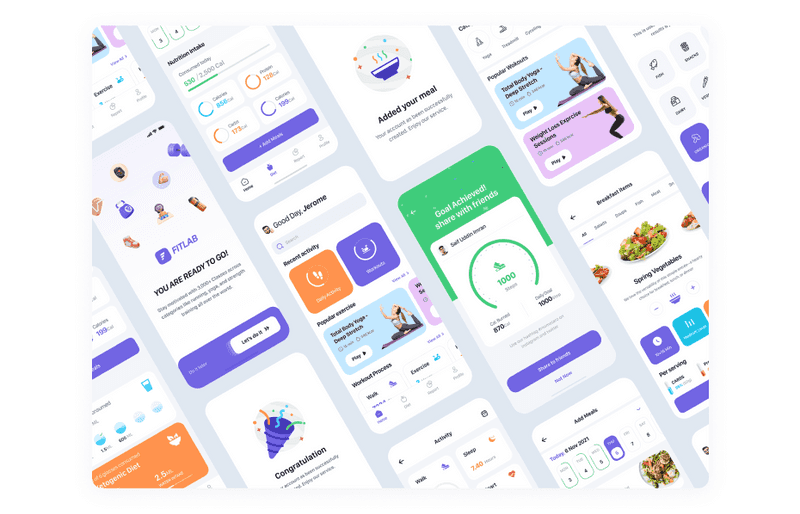
Dribbble shot by Musemind UI/UX Agency
-
Personalization
To really grab the user’s attention and get into their hearts, you need to make the application more personalized. Implement features allowing users to customize workouts and fitness goals to their preferences and capabilities. Yet, you must provide personal recommendations for activities and content based on user data. It may be problematic from an audience research and technical point of view, but it is worth it.
However, the process of building a fitness app is full of challenges. You must overcome these challenges effectively without compromising the functionality and usefulness of the application.
If you want to know how we dealt with such challenges, go to our case study about SportPlus. There, we talked about our experience building a fitness app design and the challenges we faced while working on this project.
Here, we covered some main challenges in building fitness apps. We hope these problems help you understand the basics and improve your idea.
Concluding Lines
Just like any other type of app, fitness apps can be challenging. Before building a fitness app design, you need to answer several questions. What is the idea of your app? Is it relevant? Is there any demand? Who do you design for? How do users interact with fitness app design? After answering these questions, you will have a crystal understanding of the functionality of your future app and the design principles fitness app will have to follow.
Have you got a killer idea for a fitness app? Well, don’t hold back! We’ve got some profound expertise in this field, so you’re in good hands. We’ve worked with many startups, existing businesses, and coaches, so we know our stuff. And let us tell you, we’d be thrilled to jump on board and help you create a fitness app that will rock the market! So don’t be shy, reach out to us, and let’s make some fitness magic happen!

